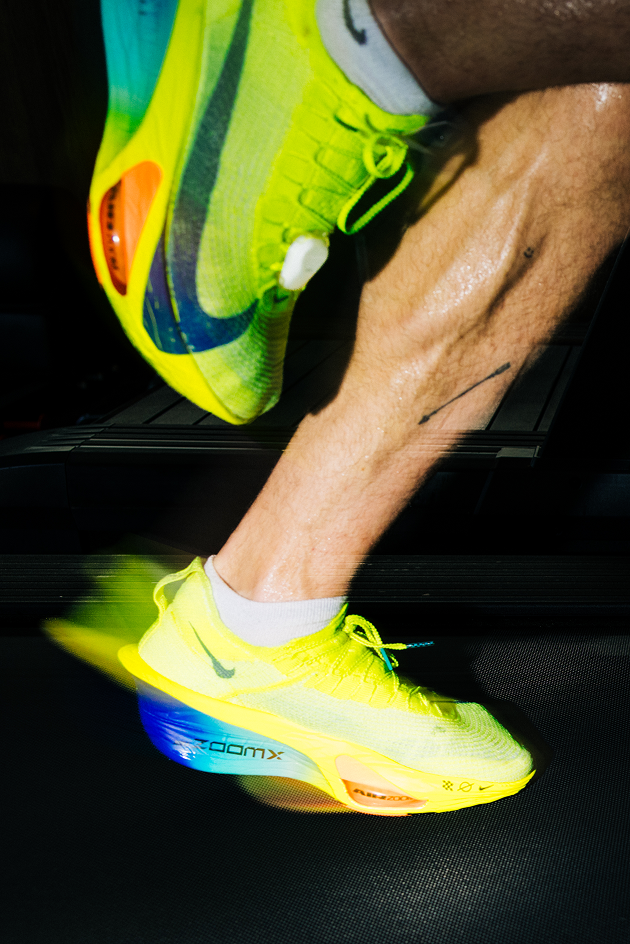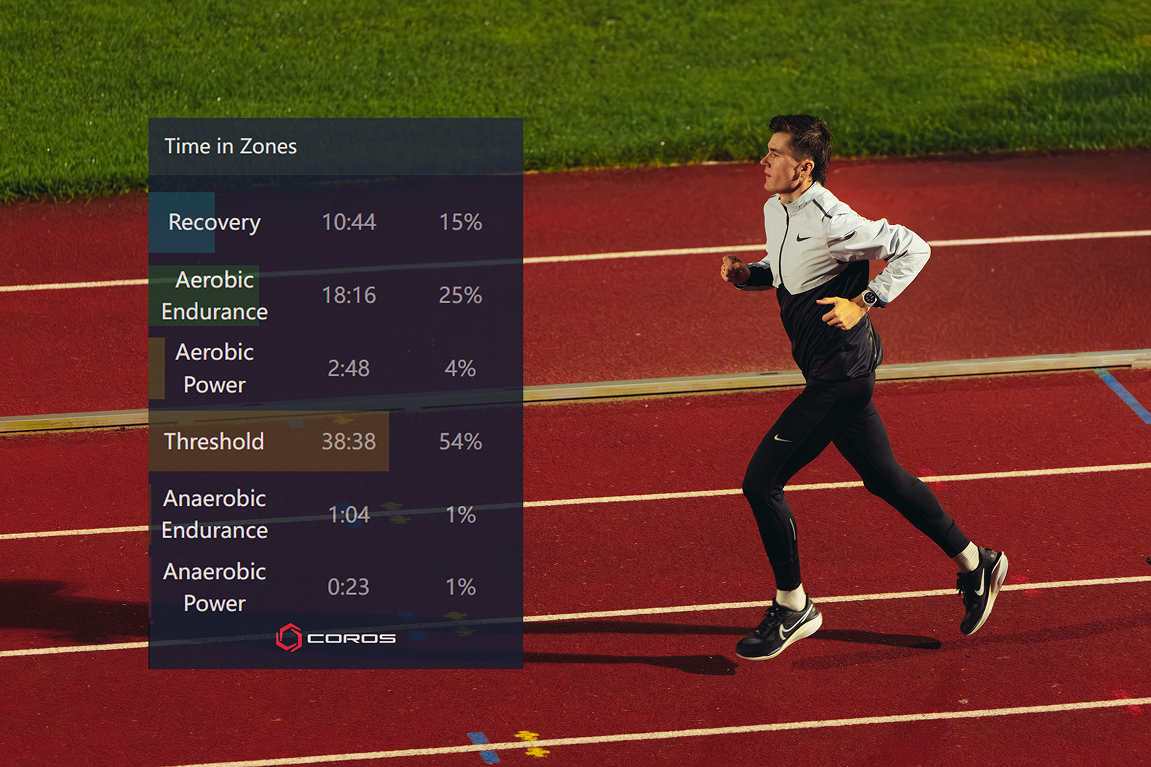What is Interval Training?
Interval training alternates periods of high-intensity work with periods of recovery. The recovery breaks allow athletes to spend more total time at higher intensities than they could in a continuous effort. This makes each session more effective, providing a stronger training stimulus. Recovery between intervals may be passive (standing or walking) or active (easy jogging), and the amount of rest depends on the intensity and purpose of the session.
Types of Interval Training
While intensity and duration exist on a spectrum, most interval sessions fall into five general categories based on their purpose. These include longer intervals at marathon effort, threshold intervals, VO2 max efforts, race pace work, and short sprint or speed-endurance intervals. Each type targets a different physiological adaptation and plays a role at specific points in your training cycle.
COROS Tip: When training with intervals, try using the COROS Workout Builder. Your structured workout will be sent to your watch and it will guide you through each rep of the workout. Afterwards, it will even tell you how closely you stuck to the plan!
1. Marathon-Pace Intervals
Also called Tempo intervals, these are longer, steadier efforts run at your goal marathon pace or just slightly faster. These workouts fall in your Aerobic Power zone (Zone 3) and are especially effective in the final 6 to 10 weeks before a marathon. The goal is to improve your ability to hold that pace late in a race, without the full fatigue of a long run.
A typical session might be 2 to 3 repeats of 3 to 5 miles each, with 3 to 5 minutes of recovery jogging in between. The rest is short enough to keep the effort continuous but gives just enough time to reset.
>> Download a Marathon-Pace Interval Workout <<
2. Threshold Intervals

Threshold intervals train your ability to sustain hard efforts without accumulating too much fatigue. These are typically run just below or right at your lactate threshold.
These intervals can range anywhere from 3 to 12 minutes, with a 60-90 second standing or jogging recovery. In total, you should accumulate about 30 minutes of work. You’re working hard, but the effort feels controlled. You should finish these workouts feeling accomplished, but not exhausted. These sessions improve your capacity to clear lactate, allowing you to run faster and maintain that pace for longer.
>> Download a Threshold Interval Workout <<
COROS Tip: Longer reps like Marathon Pace and Threshold intervals are often done on roads or trails. To account for any hills on your route, try using Effort Pace to ensure you're still running the workout as intended.
3. VO2 Max Intervals
These are high-intensity intervals designed to raise your VO2 max. They’re shorter than threshold work but more intense, falling in your Anaerobic Endurance zone (Zone 5).
A typical VO2 max session might include 5 to 6 repeats of 3-5 minutes hard with an equal amount of time for recovery. The 1:1 work-to-rest ratio allows you to recover just enough to hit each rep with quality. You’re breathing hard, your heart rate is high, and you might question if you can finish the workout early on. These are exactly the conditions that drive aerobic adaptation.
Notice that this is where the rest begins to lengthen quite a bit. When you exceed your threshold pace, fatigue mounts much more quickly, so more recovery is required between reps. The total amount of work begins to decrease as well. Even elite athletes will limit VO2 sessions to 30 minutes of work, and that continues to decrease as the intensity rises in the sections below. The extra recovery applies on a larger scale, too. VO2 Max interval sessions should be limited to once per week, as frequent repetition can lead to burnout.
>> Download a VO2 Max Interval Workout <<
4. Race Pace Intervals (5K, 3K, Mile, 800m)

These workouts are designed around specific race efforts. The intervals are typically 200 to 800 meters,with enough rest to be repeatable. Your 5K-pace intervals will fall into Zone 5, while the remainder will land in Zone 6: Anaerobic Power.
A classic session might include 8x400 meters at 3K pace with 3 minutes standing or 400 meters of jogging between. These workouts sharpen your ability to pace accurately, stay efficient at race speed, and hold pace while managing fatigue. They're especially effective in the final weeks before a target race.
Sometimes, coaches will use these paces with reduced recovery time. These sessions intentionally flood your muscles with lactate to teach your body to hold strong when the burn sets in. These sessions are typically shorter, but will leave you gasping for air unlike any other.
>> Download a Mile-Pace Interval Workout <<
5. Speed-Endurance and Sprint Intervals
At the far end of the spectrum are short, all-out efforts with full recovery. These aren’t about aerobic fitness, they’re about pure speed and coordination. It goes without saying that these are on the fast end of Zone 6 (Anaerobic Power), and they require full recovery between reps to ensure maximal quality and focus.
A pure sprint session might include 6 to 10 sprints of 5 to 15 seconds, with 3 minutes of walking between. Because the goal is maximum intensity, the long recovery ensures each effort stays high quality. These intervals are typically used by track athletes during a speed development phase.
Coaches Tip: While improving top-end speed can be beneficial for some athletes, race-pace intervals are typically better for athletes looking to improve their "5K Speed" or "10K Speed". Consult with your coach or email coach@coros.com to see which intervals match your individual training goals.
Meanwhile, a speed-endurance session is focused on teaching your body to maintain top speed for longer. These are typically 3-5 reps of 150-300m with a full recovery of 8-12 minutes. This type of workout is common for athletes targeting events from 400m to 1500m, but has little to no relevance in longer events.
>> Download a Sprint Interval Workout <<
Putting It Together
Interval training covers a broad spectrum of workouts, so be sure to know what your desired outcome is before starting a session. Marathoners and Milers will both run intervals, but the intensity and duration must match their training needs. Longer races will require longer intervals, while shorter races will utilize shorter intervals. After each session, review your Zone Distribution Chart to see if your training aligns with the intention of the workout.

These sessions will likely produce your highest training loads, and too much too soon could end up being counterproductive. It is important to track your Training Status and Intensity Trend to ensure you avoid overtraining.
With smart planning and COROS insights, intervals can be your strongest tool to develop speed, stamina, and race-day readiness.

/filters:quality(90)/fit-in/970x750/coros-web-faq/upload/images/fe4ae09404ccec81b53bbcb2baa1b288.png)




